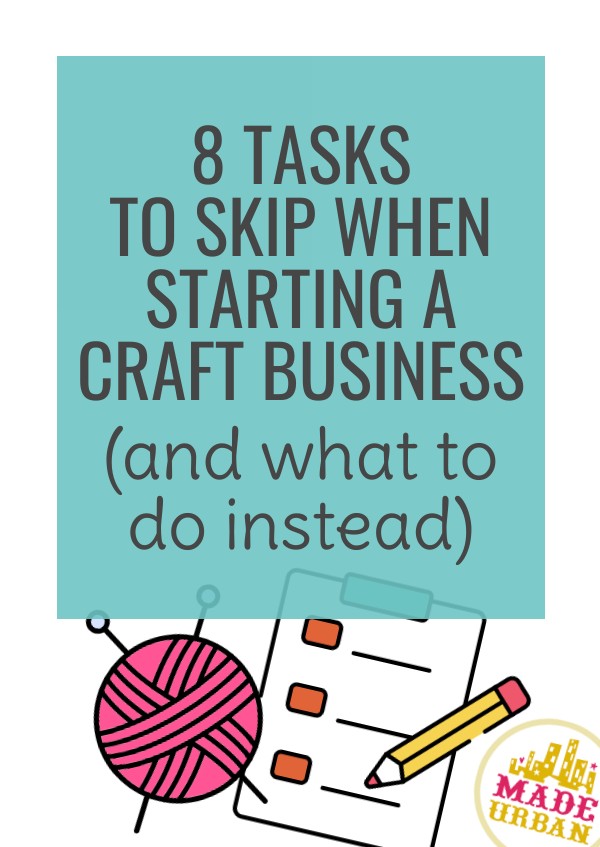8 Tasks to Skip when Starting a Craft Business (and what to do instead)
Starting a craft business can be overwhelming, with a long list of tasks to be completed. But not all start-up tasks are equal, and some can wait.
Here are the tasks I’ve found to be less essential when starting my handmade businesses, followed by ones that were worth spending time and money on from the start.
8 Tasks to Skip
The following are tasks that need to be completed eventually, but aren’t essential in the beginning, when time and money are tight, and you’re unsure whether or not the business will succeed.
Skip #1 – Developing a brand
I do think it’s a good idea to roughly define your brand from the start, so it gives you direction. But your brand may change once you get out into the marketplace.
Let’s say I’ve decided to sell scrunchies and I want to go for a cottagecore style/vibe. But when I set up at a craft show, I sell fewer cottagecore style prints and more of my solid silk scrunchies. My brand may go from cottagecore to feminine/luxury.
Try starting with 1 – 3 keywords to describe the look/feel/vibe of your brand (e.g. classic & sophisticated, or colourful and youthful, or beachy). This will be enough to guide any branding decisions you need to make and keep elements of your business consistent.
But, in my opinion, it’s unnecessary for most small handmade businesses to spend a lot on brand development before solidifying the business and its products.
Skip #2 – Professional logo
A logo is a part of your brand and if you haven’t fully developed your brand, it can be a waste of time to have a logo professionally designed.
If you start with your brand’s keywords (e.g. colourful and youthful), you can simply choose a couple of fonts and colors that align with that look/feel/vibe/style.
When you apply the fonts and colors to your business name, it creates a temporary logo that’s on-brand.
Skip #3 – Professionally printed business cards
Again, if you don’t have a brand or logo, there’s no point spending money having hundreds of business cards printed and shipped.
In the beginning stages, you may not have a business email, website, or social media accounts set up yet.
Simply purchase business card paper and print several dozen business cards at home.
Once you solidify more details of your business, set up a website, register social media accounts, define a tagline, develop branding and a logo, etc., then it’s an appropriate time to get business cards printed.
Skip #4 – A complete product line
In the beginning stages of your craft business, you’ll no doubt, have LOTS of ideas.
You don’t need to chase all of them, and you don’t need a full product line to launch your business.
Start with just a few products that you can use to gather feedback and sales information. Then let that information guide which products you make more of and develop a product line around.
Skip #5 – Building a website
Building a well-designed, responsive (i.e. mobile-friendly), fast-loading, search engine optimized website can be time-consuming. And it’s not necessary in the beginning.
You can start on a platform such as Etsy or Ecwid to keep costs low while you work out the details of your business.
Although it’s not ideal long term, you can even use social media to market your products, gather feedback, and then use PayPal to complete transactions.
Focus your efforts on finding products that sell, rather than perfecting a website. Once you know you can make sales, then it’s a good time to invest in the proper sales channels.
Skip #6 – Business plan
It is important to have a clear vision for your handmade business and explore the challenges you’ll likely face, but most business plan templates are very detailed and have you mapping out steps you may not even get to.
If you’re applying for a loan or trying to attract investors, you will need a formal business plan.
But if this business is being supported by you and you’re in the testing-to-see-what-direction-it-goes-in phase (e.g. you’ve never sold at a craft show or online and need to see where you excel), then don’t spend time writing an executive summary, SWOT analysis, etc.
Instead, have some fun creating a creative business plan.
One you’ll actually use, and that is more of a short-term vision. Your business may look completely different in a month or two, so there’s no point in forecasting the next 3 – 5 years and mapping out the next 12 months.
Skip #7 – Sourcing materials
It’s important to know what’s out there for materials and the type of pricing you can get when ordering materials in bulk.
However, spending a lot of time sourcing, finding the best prices, and ordering a lot of materials (to get them at lower prices) isn’t a good idea when you’re still testing out product ideas and determining what your market likes and doesn’t like.
Once you have proof of concept, then you can spend more time and money finding the best materials/more unique materials/the best prices/etc.
Skip #8 – Perfecting pricing
It can be difficult to know the exact price you need to charge to cover all your costs and leave you with a profit when you don’t know what all your costs are yet.
When starting out, it can be more time-effective to reverse-engineer your prices (here’s how to do that How To Keep your Product’s Price Competitive).
Meaning, find an average price for your product, based on what your competitors are charging, and make sure you can create your item for that price.
As you develop product features, buy materials in bulk, streamline your processes, get to know your target market (and their budget), develop your brand (e.g. is it a luxury brand that warrants higher prices?), uncover how many hours you spend to run your business, spend money and determine your average monthly expenses, etc. then you can set more accurate pricing.
5 Tasks To Focus on
Now that you have an idea of what can wait, here are 5 tasks that require your time and money from the start.
1 – Get set up legally
Be sure to check your local laws to find out what is required to start a business and sell products.
When I started my first handmade business, I didn’t take the proper steps. Months later, when I went to register my business name, I was told it was taken by another local business and I couldn’t use it as is.
I was able to make a minor change to the name, and it didn’t cause too big of a hiccup, but I got lucky.
Registration, licences, permits, regulations, sales tax laws, etc., are things that should be followed from the start.
2 – Choose a name
In most cases, you’ll need to register your business. And to register a business, you’ll need a business name.
You’ll also need a name to set up social media accounts and secure a domain name.
Choosing a business name can be a hard step because you may not know exactly what you’re going to sell, where and how you’ll sell, your brand, etc.
However, it can be beneficial to choose a business name at this point because it forces you to be a little more vague…which ensures you have room to change/expand in the future.
Here are tips for choosing a name for your craft business:
- What should I name my craft business? 5 Tips
- 3 Steps to Take Before Deciding on a Craft Business Name
- Craft Business Names (that are actually good)
3 – Register names online
Once you decide on your craft business name, you’ll likely need to register it with your province/territory/state. Then you should secure the domain name and social media accounts.
You don’t need to get a website up or start posting to those accounts right away. But registering them saves the name so someone else doesn’t start using it online.
4 – Minimal Viable Product
Every single business I’ve created (and I’ve created many) has started as something quite different than what I ultimately found success with.
The early stages of running a business will be about testing products and seeing what your target market responds to (i.e. buys). So there’s no point in launching with a perfected product line.
Many products I was sure would be a hit ended up flopping, and I wasted hours and a lot of money creating what I thought was a perfect version of it. A minimal viable version of those products would have saved me time and money.
A minimal viable product is basically the simplest version of a product you can put out there to sell.
The reason you want to create a minimal viable product, instead of a perfected version of your product with all the bells and whistles, is that it allows you to spend minimal time and money on a product that may or may not sell.
5 – Craft shows
There are many ways you can market and sell your handmade products. But selling at craft shows is a great way to test a business idea and gather feedback.
It can be harder to profit (or profit a lot) from craft shows because they often require many hours to prepare for and sell at, as well as the associated costs your sales must cover (10 Costs of Selling at Craft Fairs).
Although you may not have the highest profit margins from your first few craft shows, they will get shoppers in front of your business and allow you to ask them questions, observe their behaviour (e.g. do they pick up one product a lot but put it down after seeing the price?) and (hopefully) gather valuable stats (7 Stats to Track at Craft Shows (to improve sales)).
Setting up at a craft show can get your business in front of hundreds of people over several hours. Online, it can take weeks, months, or even years to drive hundreds or thousands of shoppers to a website/shop/listing in a day.


Hey, I’m Erin 🙂 I write about small business and craft show techniques I’ve learned from being a small business owner for almost 2 decades, selling at dozens of craft shows, and earning a diploma in Visual Communication Design. I hope you find my advice helpful!
